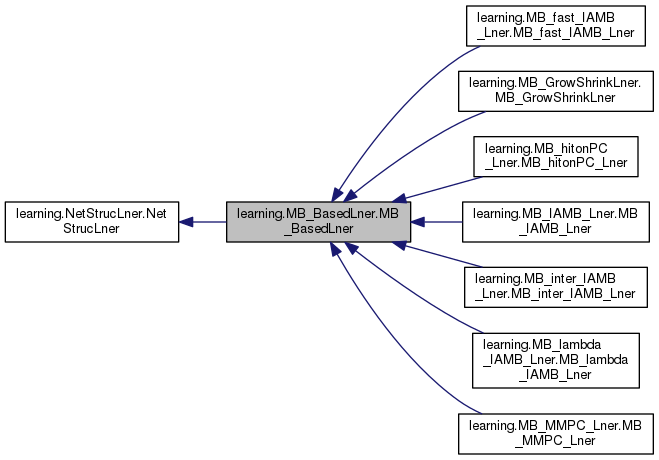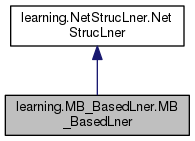 |
Quantum Fog
0.9.3
|
 |
Quantum Fog
0.9.3
|


Public Member Functions | |
| def | __init__ (self, states_df, alpha, verbose=False, vtx_to_states=None, learn_later=False) |
| def | learn_struc (self) |
| def | find_MB (self, vtx=None) |
| def | find_nbors (self) |
| def | orient_edges (self) |
| def | new_filled_nx_graph (self) |
| def | undo_cycles (self) |
| def | orient_undecided_edges (self) |
 Public Member Functions inherited from learning.NetStrucLner.NetStrucLner Public Member Functions inherited from learning.NetStrucLner.NetStrucLner | |
| def | __init__ (self, is_quantum, states_df, vtx_to_states=None) |
| def | fill_bnet_with_parents (self, vtx_to_parents) |
Static Public Member Functions | |
| def | MB_lner_test (LnerClass, verbose=False) |
 Static Public Member Functions inherited from learning.NetStrucLner.NetStrucLner Static Public Member Functions inherited from learning.NetStrucLner.NetStrucLner | |
| def | learn_nd_state_names (bnet, states_df) |
| def | import_nd_state_names (bnet, vtx_to_states) |
| def | int_sts_detector (sub_states_df) |
Public Attributes | |
| alpha | |
| verbose | |
| vtx_to_MB | |
| vtx_to_parents | |
| vtx_to_nbors | |
 Public Attributes inherited from learning.NetStrucLner.NetStrucLner Public Attributes inherited from learning.NetStrucLner.NetStrucLner | |
| is_quantum | |
| bnet | |
| states_df | |
| ord_nodes | |
MB_BasedLner (Markov Blanket Based Learner) is an abstract class for
learning the structure of a bnet by first finding the markov blanket of
each node, then using that MB info to find the neighbors of each node,
then orienting the edges of each node with its neighbors. The procedure
for orienting the edges is not 100% effective and must be patched up (
it might introduce some cycles and leave some edges undecided. A
heuristic is introduced to patch things up.
The first MB based learner was Grow Shrink (referring to growing and
shrinking of the MB) by Margaritis. See Refs. 1 and 2 for his original
paper and his 2003 Thesis at Carnegie Mellon.
Many variations of Grow Shrink were introduced after it. In Quantum Fog,
Grow Shrink and all its variants are subclasses of this class,
MB_BasedLner, and their names all start with 'MB_' for easy
identification and so they all stay together in an alphabetical listing
of files.
Ref. 3, the PhD thesis of Shunkai Fu, was very helpful in writing the
MB_ classes, because it contains pseudo code for most of the MB_
algorithms. However, note that in that pseudo code, whenever it says I <
epsilon, it means that the conditional mutual info I > epsilon.
See Shunkai Fu Thesis if you want to know who invented each MB_
algorithm and in which papers they proposed it for the first time. The
References given below are not necessarily the first papers, but rather
papers wih good pseudo code
References
----------
1. D. Margaritis and S. Thrun, Bayesian Network Induction via Local
Neighborhoods Adv. in Neural Info. Proc. Sys. 12 (MIT Press, 2000)
2. D. Margaritis, Learning Bayesian Network Model Structure from Data,
Thesis 2003 (Carnegie Mellon Univ.)
3. Shunkai Fu, Efficient Learning of Markov Blanket and Markov Blanket
Classifier, Thesis 2010, UNIVERSITÉ DE MONTRÉAL
4. Jean-Philippe Pellet, Andre´ Elisseeff, Using Markov Blankets for
Causal Structure Learning (Journal of Machine Learning Research 9, 2008)
5. Nicholas Cullen, NeuroBN at Github
Attributes
----------
is_quantum : bool
True for quantum bnets amd False for classical bnets
bnet : BayesNet
a BayesNet in which we store what is learned
states_df : pandas.DataFrame
a Pandas DataFrame with training data. column = node and row =
sample. Each row/sample gives the state of the col/node.
ord_nodes : list[DirectedNode]
a list of DirectedNode's named and in the same order as the column
labels of self.states_df.
alpha : float
threshold used for deciding whether a conditional or unconditional
mutual info is said to be close to zero (independence) or not (
dependence). The error in a data entropy is on the order of ln(n+1)
- ln(n) \approx 1/n where n is the number of samples so 5/n is a
good default value for alpha.
verbose : bool
True for this prints a running commentary to console
vtx_to_MB : dict[str, list[str]]
A dictionary mapping each vertex to a list of the vertices in its
Markov Blanket. (The MB of a node consists of its parents, children
and children's parents, aka spouses).
vtx_to_nbors : dict[str, list[str]]
a dictionary mapping each vertex to a list of its neighbors. The
literature also calls the set of neighbors of a vertex its PC (
parents-children) set.
vtx_to_parents : dict[str, list[str]]
dictionary mapping each vertex to a list of its parents's names | def learning.MB_BasedLner.MB_BasedLner.__init__ | ( | self, | |
| states_df, | |||
| alpha, | |||
verbose = False, |
|||
vtx_to_states = None, |
|||
learn_later = False |
|||
| ) |
Constructor
Parameters
----------
states_df : pandas.DataFrame
alpha : float
verbose : bool
vtx_to_states : dict[str, list[str]]
A dictionary mapping each node name to a list of its state names.
This information will be stored in self.bnet. If
vtx_to_states=None, constructor will learn vtx_to_states
from states_df
learn_later : bool
False if you want to call the function learn_struc() inside the
constructor. True if not.
Returns
-------
None
| def learning.MB_BasedLner.MB_BasedLner.find_MB | ( | self, | |
vtx = None |
|||
| ) |
This function finds the MB of vtx and stores it inside vtx_to_MB[ vtx]. If vtx=None, then it will find the MB of all the vertices of the graph. This function is overridden by all the subclasses of this class (the ones with names starting with MB_). All the other functions called by learn_struc() are the same for most of the subclasses of this class. Parameters ---------- vtx : str Returns ------- bool
| def learning.MB_BasedLner.MB_BasedLner.find_nbors | ( | self | ) |
Finds for each vtx of the graph, a list of all its neighbors and puts that info into vtx_to_nbors. Returns ------- None
| def learning.MB_BasedLner.MB_BasedLner.learn_struc | ( | self | ) |
This is the orchestra conductor of the symphony. Each of the functions it calls does a lot. By the end, a whole bnet structure has been learned from the data and has been stored in self.bnet. Returns ------- None
|
static |
This static method gives a simple example that we use to test
MB_BasedLner and its subclasses (those starting with MB_). The
method takes as input training data generated from 2 graphs (the
classical versions of wetgrass and earthquake) and it outputs a
drawing of the learned structure.
Parameters
----------
LnerClass : MB_BasedLner or subclass
This is either MB_BasedLner without quotes or the name of a
subclass of that class.
Returns
-------
None
| def learning.MB_BasedLner.MB_BasedLner.new_filled_nx_graph | ( | self | ) |
This function fills nx_graph with the info found in vtx_to_parents. Returns ------- networkx.DiGraph
| def learning.MB_BasedLner.MB_BasedLner.orient_edges | ( | self | ) |
This function gives an orientation to some (not necessarily all) the undirected edges implied by vtx_to_nbors. The edge orientation info found by this function is stored by it in vtx_to_parents. Returns ------- None
| def learning.MB_BasedLner.MB_BasedLner.orient_undecided_edges | ( | self | ) |
When this function is called in learn_str(), the vtx_to_parents that has been learned so far may not include all of the edges implied by vtx_to_nbors. Hence, there might still be some undirected edges. This function uses a reasonable but not rigorous heuristic to orient those undecided edges. Returns ------- None
| def learning.MB_BasedLner.MB_BasedLner.undo_cycles | ( | self | ) |
When this function is called in learn_str(), the vtx_to_parents that has been leaned so far may imply (directed) cycles. This function uses a reasonable but not rigorous heuristic to reverse the direction of at least one arrow in each cycle and make it a non-cycle. Returns ------- None
 1.8.11
1.8.11